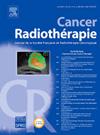Tolérance à court et moyen terme d’une radiothérapie prostatique hypofractionnée selon la technique du boost intégré
IF 1.4
4区 医学
Q4 ONCOLOGY
引用次数: 0
Abstract
Purpose
This retrospective study was conducted to ensure that irradiation of the pelvic lymph node areas associated with simultaneous hypofractionated boost to the prostate according to the protocol implemented at the university hospital of Tours (France) does not result in excess urinary and digestive toxicity in the short and medium term.
Materials and methods
The study population included patients with localized unfavourable intermediate or high-risk prostate cancer. The dose delivered was 65 Gy in 25 fractions of 2.6 Gy to the prostate and seminal vesicles, and 50 Gy in 25 fractions of 2 Gy to the pelvic lymph nodes. Acute toxicity events (between the start of radiotherapy and the first follow-up consultation) and medium-term toxicity events (after the first follow-up consultation) were assessed using the CTCAE version 5.0 classification.
Results
Sixty-three patients were treated according to the protocol between January 1st, 2020, and October 31st, 2022. The majority of them had high-risk prostate cancer (79%). The median follow-up was 15 months. Very few patients reported grade 3–4 toxicity acutely (6% urinary and 0% digestive toxicity) or in the medium term (7% urinary and 0% and digestive toxicity).
Conclusion
Radiotherapy of pelvic lymph node areas with simultaneous hypofractionated boost to the prostate is feasible, with low rates of severe acute and medium-term toxicity.
[前列腺低分次同步综合增强放疗的短期和中期耐受性]。
目的:本项回顾性研究旨在确保根据图尔大学医院(法国)实施的方案对盆腔淋巴结区域进行照射并同时对前列腺进行低分量照射不会在中短期内导致过多的泌尿和消化系统毒性:研究对象包括局部不理想的中度或高度危险前列腺癌患者。前列腺和精囊的放射剂量为 65Gy,25 次分次放射,每次 2.6Gy;盆腔淋巴结的放射剂量为 50Gy,25 次分次放射,每次 2Gy。急性毒性事件(放疗开始至首次复诊期间)和中期毒性事件(首次复诊后)采用 CTCAE 5.0 版分类进行评估:在2020年1月1日至2022年10月31日期间,63名患者按照方案接受了治疗。其中大多数患者患有高风险前列腺癌(79%)。中位随访时间为 15 个月。极少数患者报告了3-4级急性毒性(6%为泌尿系统毒性,0%为消化系统毒性)或中期毒性(7%为泌尿系统毒性,0%为消化系统毒性):结论:对盆腔淋巴结区进行放疗,同时对前列腺进行低分次照射是可行的,急性和中期严重毒性发生率较低。
本文章由计算机程序翻译,如有差异,请以英文原文为准。
求助全文
约1分钟内获得全文
求助全文
来源期刊

Cancer Radiotherapie
医学-核医学
CiteScore
2.20
自引率
23.10%
发文量
129
审稿时长
63 days
期刊介绍:
Cancer/radiothérapie se veut d''abord et avant tout un organe francophone de publication des travaux de recherche en radiothérapie. La revue a pour objectif de diffuser les informations majeures sur les travaux de recherche en cancérologie et tout ce qui touche de près ou de loin au traitement du cancer par les radiations : technologie, radiophysique, radiobiologie et radiothérapie clinique.
 求助内容:
求助内容: 应助结果提醒方式:
应助结果提醒方式:


